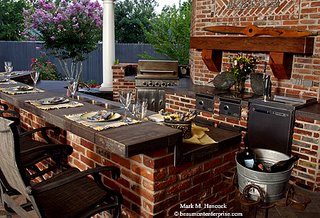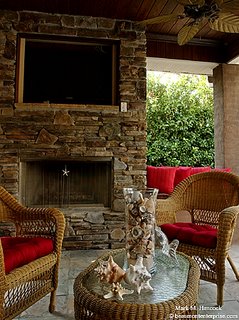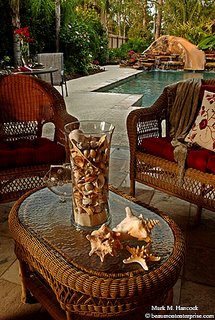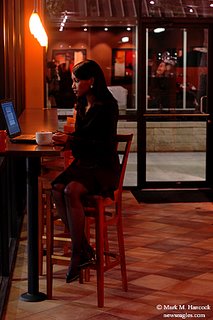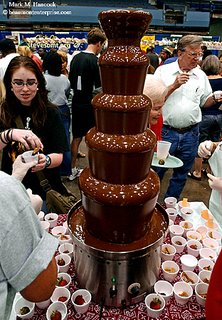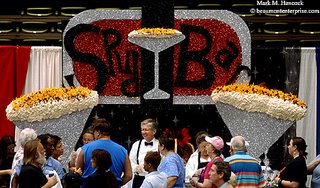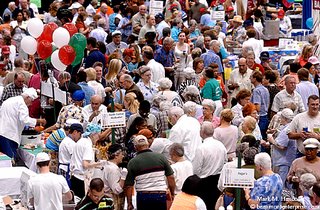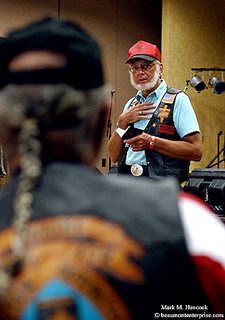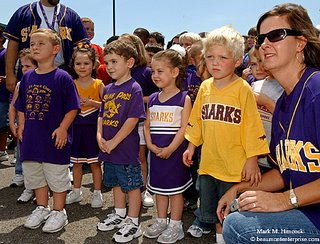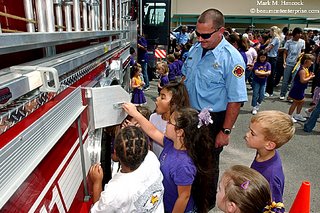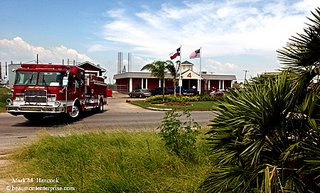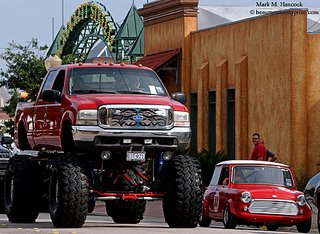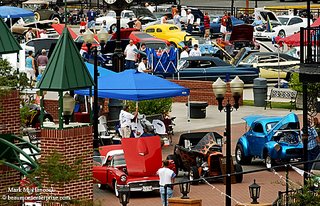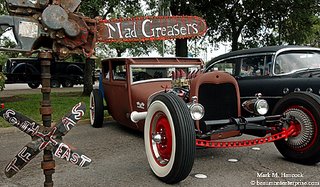Even folks unacquainted with the nuances of style can accurately identify which images belong to different photographers by the way the finished images look.
As casual observers flip through the pages of their favorite newspapers or magazines, they can easily spot images taken by a particular PJ. Over time, they learn to look for (or avoid) images produced by specific PJs. They may never look at the credit line, but they know how these images look and where the images tend to appear.
Style is an often misunderstood term. Style is the way an artist approaches art from beginning to end. A style is a consistent combination of choices. Often an artist's style falls within one broad category and is further defined by the artist's preferences, skills, equipment choices, subject matter and final image treatment.
All accomplished artists have their own style - whether they know it or not. It's simply how they do what they do. A style is a reflection of the artist. Like a fingerprint, the work is easily identified as belonging to a specific artist.
Some artists realize the importance of style and make a conscious effort to deviate from their peers to stand alone. Separating oneself from the crowd occurs in everything from writing to sculpture to photography and beyond.
Understand general stylePeople already understands style but may have never thought of it in a visual context. Let's look at personal styles and understand how style works in general.
Each morning, people around the world wake up, clean up and display their styles for others to see. A manager wears a pinstripe suit. She may wear high heels. She may pull her hair back. This is her style.
Another worker puts on his blue jeans, snap-front shirt, boots and hat. He probably adds spurs and chaps depending on where he works. We know this man's profession simply from his clothing style.
Tools of the trade also determine style. When we consider music, we try to organize songs into different styles. If we see a musician preparing for a show, we can often ascertain their musical style by both clothing and instruments.
For example, we see a person in jeans and boots preparing a pedal steel guitar. We know this person's exact musical style. Unless s/he is a cross-over artist of some sort, this person performs country and western music.
Believe it or not, the same holds true for different photographers. Although photographers do shift styles for different assignments, this quiz should encapsulate
many photographers by both their clothing and camera selection. The answers are at the bottom of this section. See if you can name the photographic style and the photographers.
1. Business suit and tie with a medium format or 35mm digital camera.
2. Khaki trousers, white button-down shirt, view camera.
3. Blue jeans, flannel or polo shirt, sneakers or boots, 35mm digital camera.
4. Trendy business casual, view camera.
5. Black turtleneck and trousers, medium format camera.
Again, these styles simply identify
many people in these fields of photography. Not everyone fits neatly into these molds, but we should get the point. Now, consider your own camera and what's in the closet. Even if these don't reflect your profession, they say a lot about your style.
The photographers described above tend to be the following fields:
1. portrait photography
2. architectural photography
3. photojournalism
4. commercial photography
5. fashion photography
Avoid the style trapOne of my college friends turned out to be a fine fashion/travel photographer. He has acquired many skills over the years and amassed a good portfolio. However, his college experience serves as a lesson.
After our first two years of college, he and I went to different universities to complete our bachelor degrees. My university emphasized the technical aspects of photography and journalism while his university focused on the artistic aspects.
While I was learning chemistry and refining techniques in printing, lighting and portraiture as well as intense journalistic training, he was being encouraged to find his individual artistic style.
His instructors helped him
choose his style.
Did you hear a needle rip across the record?
Yup, while I learned a plethora of photographic techniques and the minutia of densitometry, he was busily working on his "style." What was the style his instructors decided he needed to follow? Available light images of amateur female fashion models shot on 3200 ISO B&W film. He was responsible for his own printing technique because it was part of his supposed style.
I tried to convince him that he was being sent down a wrong path. The style he chose - since he called it as such - wouldn't allow him to make a living. He heard none of my warnings.
I graduated with a B.S. degree and a solid background in photography and journalism. He graduated with a B.A. degree and an artistic "style." I worked freelance gigs at different publications and landed a staff job after a few months. He struggled for several years trying to find work through hair salons and such. Luckily, his family had sufficient wealth to support him.
As I said earlier, there's a happy ending to his story. However, it took at least four years for him to get his total technique up to a professional level. Now, he shoots mostly fine-grain (low ISO), saturated color images with studio strobes in exotic locations. His specialties include fashion, weddings and commercial work. In other words, he's doing the exact opposite of the "style" his instructors thrust upon him.
This was a long story to explain the importance of refining technique before worrying too much about style. Again, style is a reflection of the artist. It can't be forced. If a particular photography style is adopted before all options are tested, the style can't possibly match the artist. Ignorance isn't a style.
Develop your own stylePick a photo fieldThe first major step is to determine which
genre of photography is best for the photographer. This is determined by individuals' goals and inclinations. Often, a set of questions direct photographers in the right direction.
How important are the following issues:
money --> commercial
job security --> corporate
travel --> freelance editorial PJ
fame --> fashion
idealism (making the world better) --> social documentary
working alone --> architectural
being in nature --> nature photography
being in a big city --> street
telling stories --> photojournalism
pleasing photo subjects --> portraiture
controlling the shoot from beginning to end --> art director
documenting social interactions --> visual sociology
the creative process --> fine art.
Each question directs photographers toward a specific field. Although several questions may be options for the right photographer, most are one-way tickets.
Get the right educationWhen PJs think about education, we think about a formal degree (bachelors or masters). This is because many people want to be PJs. So, employers require the degree to eliminate candidates. Unless the candidate already has a Pulitzer Prize, can speak 20 languages, etc. the first cut is always those without degrees.
However, in other photography fields, a degree isn't always the starting point. Although I believe a degree is useful in any field of photography, some photo-related jobs don't require a degree.
Many successful portrait and commercial photographers have no degree.
Instead, they went through an elaborate apprenticeship or mentorship and learned on the job. They found an employer or mentor to teach them the entire business in two years.
While they may initially get a two-year jump on their competition, they take a huge risk by learning a specific job without enough general education to react to market changes. In other words, if the market dries up, they may not have the background to shift gears and survive the change.
Either way, photographers need to seek the best education they can. If the photo student goes to a university, go to the
best-qualified university per dollar. Find one with proven results in the desired field or one with a wide array of successful graduates in a number of different fields (possibly a better option).
If a photographer plans to enter a field other than PJ work and prefers to enter a mentorship arrangement, make sure it's with the absolute top photographer in the field. Lately, even these top photographers are culling the herd by demanding degrees, but it's still an option.
If a photographer does choose this route, it would be extremely wise to have a specific contract of terms with the mentor. After the mentorship period ends, it would behoove the photographer to immediately move into a second mentorship with a different photographer for a shorter period. This second experience should fill-in any educational gaps from the first experience.
Get the right equipmentOnce the best field and the right educational route has been chosen, get the right equipment.
Photography equipment is outrageously expensive. PJ work has one of the least expensive starting points at about $10,000. So, imagine the cost of a professional view camera, a full set of studio lights as well as a studio or other storefront.
Consequently, it's vital for photographers to understand enough about themselves to invest their money wisely. Sinking cash into a serious view camera and then deciding medium format is more appropriate costs the photographer about the same as pushing an uninsured car off a cliff. But, it's only money and time.
Specialized styleIn commercial photography, specializations of style are quite pronounced. A commercial photographer may choose her/his style to be neon-lit, flowing water over lava rocks with a 8-by-10 view camera at f/64. This commercial photographer may be known worldwide for this particular style. Anytime a commercial client wants their product to be seen with this treatment, they know exactly whom to call.
Extreme specialization is a result of market demand. Although most established commercial photographers can do an exquisite job on any product, they corner certain markets by specialization. This ensures their survival through their unique expertise and depth of experience in a specific treatment.
Auto manufacturers, for example, depend on a specific set of commercial photographers for their various products. The job requires a photographer to capture a large, highly-reflective object with a large format camera (for larger-than-life displays). Another specialist may be employed to capture the auto traveling through the mountains in perfect light with an evocative background. A third specialist may be employed to set the vehicle on a mountaintop via helicopter and shoot it from the air or another mountain location.
All these commercial photographers are specialists. They already have experience and proven results with these extremely difficult assignments. Clients contract with these specialists because there's too much money on the line with the new product. The client wants to be absolutely certain the job is done right by a specialist.
Photojournalism styleAs we discussed before, photojournalism is a field of photography. As such, it is also a style of photography.
A photojournalistic style - at its optimal level - is an ethical and compelling marriage of words and images denoted by emotional, factual story-telling images from a neutral observer. Because photojournalistic images are juxtaposed with words, the images frequently capture visual verbs.
The camera used by
most PJs is a digital SLR (single-lens reflex), also called a
dit. This allows PJs the widest variety of lenses and accessories as well as the fastest means of quality image delivery.
As digital video increases in professional applications and quality, it's gaining some ground for daily assignments, however it currently isn't as versatile as the SLR.
Out of necessity, most PJs are generalists rather than specialists. They must be able to handle any assignment thrown at them. However, most PJs still lean toward certain specialties based on their interests, abilities, experience and equipment. Although all PJs can capture mug shots in their sleep, some large-newspaper PJs tend to get more sports, illustrations or crisis assignments than other shooters.
Unless a PJ is a "one man band" at a small paper or magazine, specialization and preferences begin to establish the shooter's style. A PJ's style is a series of incremental steps over several years.
Although a young PJ fresh out of college could be thrown into a war zone and produce images, the PJ's likelihood of survival or image quality is questionable. Even if they do survive, their ability to function as a human afterward is highly unlikely.
Typically, newly graduated PJs either dive into the editorial freelance market (a harsh reality) or try to land a job at a smaller newspaper. Either way, they must immediately learn the lessons they were never taught in college.
They must learn how to make a living with a camera. They must learn
what photography is worth and a
long list of other professional issues. These are lessons best learned while not ducking bullets and bombs.
The mental challenges and ethical dilemmas of PJ work also requires some on-the-job training and experience before young PJs are surrounded by an entire country of starving people.
Just as an athlete must slowly break down muscle to build more, PJs must suffer along with subjects at higher and higher levels of anxiety until they can at least function while documenting inhumane conditions.
I'm not minimizing the anguish of a person loosing their home to a fire in America, but it pales in comparison to African genocide. Young PJs must be able to calmly and compassionately document the first story if they ever plan to mentally survive the latter.
PJ ethicsThe
ethical code of behavior for PJs creates the overarching paradigm of the style. Unlike other forms of photography, PJ work has a relatively strict code of ethics to ensure images remain truthful. These ethical considerations aren't optional - they're required.
Most other forms of photography intend to sell products and services or are lumped into "art" categories, which have no ethical limitations on final images. However, when working as a PJ, photographers from other specialties must conform to the PJ ethical code or their work won't be accepted for publication.
Individual styleAs mentioned earlier, individual style is unique to each PJ. Each part of the PJ factors into the final images.
Uncontrollable factorsSome easily noticed style differences might result from uncontrollable factors such as height, gender, race or optical predispositions (near or far sightedness, dyslexia, missing eye, color blindness, etc.). Other style differences may result from environmental backgrounds such as native language, country of origin, a PJ's parent's income, pet ownership and more.
None of these factors are good or bad. They simply "are." As such, these are as much a part of the PJ's style as anything s/he deliberately does.
Controllable factorsLike the uncontrollable factors, controllable factors often manifest in a PJ's final images. These could include education, marital status, military experience, additional languages, cross-cultural experience, world travel, property ownership and more.
The controllable factors often equate to access or understanding. As PJs mature and gain experience (both positive and negative) their style evolves. Although these factors also "are," they are because the PJ
chose to experience most of these factors.
Deliberate factorsDeliberate choices and preferences are the most distinct and frequently separate PJs from the pack. Unlike the previous two factors, PJs act to intentionally distinguish themselves.
Common deliberate factors include preferences such as backgrounds, layering, compositions, camera brands, lenses, accessories, subjects, processing, post production (pre-press), film or digital,
paper or plastic, etc.
In all cases, PJs make these decisions consciously or at least out of habit.
Reactionary factorsAlthough most PJs don't like to admit it, their styles occasionally morph due to the desires of others. The most common and significant style changes come from editorial, managerial, corporate or legal changes.
A night in jail could certainly change a young PJ's approach to some assignments. Likewise, a new editor with a strong predisposition for or against particular styles has a heavy influence on the PJs assigned to work with this person.
For example, a PJ who loves tilted horizons isn't going to get them past an editor who refuses to run them. Consequently, the PJ either stops shooting tilts or may only shoot this way for freelance clients or personal images.
PJs are relatively social creatures with an average desire to make others happy and avoid unnecessary stress. If a minor reactionary change must take place for peace to exist, PJs often make the change. If it's too extreme, they look for the nearest exit.
Others sometime define styleBecause youngsters read this blog, I won't name the name, but a particular art photographer is known less for his still-life images of flowers (his art style) than for his imitation of Ricky Ratt (style revealed after his death).
The point is that we don't get to determine how (or even IF) photography historians classify our images. Furthermore, we don't even get to choose which image is our "masterpiece" or which images are included in our own final collection.
I can promise no previous photographers woke up one morning and started introducing themselves as "the mother/father of ____ style." OK, maybe
Fox Talbot,
Louis Jacques Mande Daguerre and
Man Ray, but it's their styles. ;-}
Refining styleThroughout a PJ's career, their style should be refined. It's not so much a conscious effort as a result of their experience.
I see style as a luscious dessert. It is made of many ingredients. However, there is no recipe. We can't eat it during our lifetime, but we can taste it and add or subtract to the recipe as we acquire new ingredients.
We may add some sugar to our style from portrait photography. We might add a little spice from our commercial gigs. We could subtract something after speaking with an editor.
But, after all is said and done, it's simply a dessert we can take pride in. It tastes right to us. If other people don't like it, they can bake their own style. There can never be too many desserts or photography styles.
Enough for now,
 Staff sergeants Ronsoni Long (left) and Jesus Zuniga (right) of the Houston Recruiting Battalion supervise U.S. Army recruits at the American Legion Post in Beaumont on Saturday, July 16, 2005. The recruits also toured the Port of Beaumont and viewed military equipment.
Staff sergeants Ronsoni Long (left) and Jesus Zuniga (right) of the Houston Recruiting Battalion supervise U.S. Army recruits at the American Legion Post in Beaumont on Saturday, July 16, 2005. The recruits also toured the Port of Beaumont and viewed military equipment.

